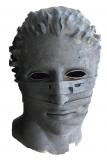Results 1 to 8 of 8
-
12-02-2014, 12:20 PM #1Student

- Join Date
- Dec 2014
- Posts
- 19
hollow metal objects from your 3d prined ones?
I've seen people using the "lost PLA/ABS" method of getting a metal objects from 3d printed (or not) plastic ones.
But increasing the size of the object the metal version can , well, get pretty heavy and also kind of expensive.
So I'm wondering is there some technique that can be used to create *hollow* metal objects by only having a plastic version of it (or its mold, or whatever) in the beginning?
PS. Yes I know the possible side effects of molten metal.
-
12-02-2014, 09:30 PM #2Staff Engineer

- Join Date
- Jan 2014
- Location
- Oakland, CA
- Posts
- 935
Sure, there are several methods that come to mind. One is the venerable lost wax casting method you mention, where the plastic would substitute for the wax. Encase your hollow print in a plaster/sand mixture, burn out the plastic in a kiln, pour metal in the mold, then remove the plaster. PLA is supposed to burn out fairly cleanly.
Another method is electroforming. You paint the model with a conductive lacquer, then put it in a solution with a lot of free copper ions. Using a controlled power supply, attach the model to a cathode, and using a piece of pure copper as an anode, build the copper up on the surface to the desired thickness. You can then dissolve out the plastic (PLA dissolves in a lye solution) or leave it in. A related process is called "electrotyping" which works the same way, except that you make a mold of the model, paint the conductive lacquer in the mold, then build up its thickness until it's strong enough to peel out of the mold without distortion. Once that's done, you can electroform the outside, so copper is all you see.
Andrew Werby
Juxtamorph.com
-
12-03-2014, 12:32 AM #3Student

- Join Date
- Dec 2014
- Posts
- 19
Thanks for the reply.
I actually thought of electroplating then getting rid of the ABS in acetone tank or heating it until it melts, but one problem I have in mind with electroplating: won't making it thick enough cause distortions and get rid of fine detail?
I made a video to explain what I mean:
Of course it gets too thick in this video, but its an exaggeration to show what I mean clearly. You can see for example the mouth of that monkey head almost disappears.
As for electroplating a mold which will overcome this above issue, that's a good idea actually. I guess I could print the mold in two parts so I can easily paint the insides before connecting them, then have a hole in the mold where the metal particles will go through to stick to the walls. Will that work? Will the hole allow an even and complete covering of the inside of the mold?
As for the first option, sorry I didn't get it.
-
12-03-2014, 02:24 AM #4
I think that if your model if "simple" enough that you can remove in the design the added thickness of electroplating, it is the simplest solution. However, that implies a good knowledge of the process and is not easily applicable to any design.
As for lost PLA casting, it is possible to create hollow objects, but depending on the design you will need inserts or multiple drawer molds that also require a fair bit of engineering.
-
12-15-2014, 08:09 PM #5Student

- Join Date
- Dec 2014
- Posts
- 19
Should I even try electroplating the insides of a mold, or it won't work?
-
12-16-2014, 12:56 AM #6Technician

- Join Date
- May 2014
- Location
- hiding in your pillow
- Posts
- 52
hmm... you can roto-cast plastic... I wonder if you could roto-cast metal (provided you had a high temp external mold... of course this would be extremely dangerous. Spinning liquid metal....
-
12-16-2014, 06:33 AM #7
-
12-16-2014, 06:59 AM #8
The only steel pipes/tubes I've dealt with the production end of were rolled steel and welded. I had just assumed non welded tubes were rolled or cast at the forge/mill.
If you use a metal with a (relatively) low melting point, you could probably make a home build roto-cast. Recently saw a decent one on Thingiverse (http://www.thingiverse.com/thing:570773), plan on building that one day, BUT the design is simple enough that you could fairly easily convert it to steel I-beams and with some basic welding construct the frame. Nice thick flat plate to cap the sandcast vessel, big ole massive clamps, decent engine or electric motor to turn the beast, good sized safe zone, and you should be all set. You'd need the heavy frame to handle the mass of the casting vessel, as it would have to be pretty thick to handle the heat, especially on the flat plate.
Yes, not for the average hobbyist, but the guys who do that pumpkin chunkin competition come to mind.




 Reply With Quote
Reply With Quote







Extruder not feeding during print,...
04-24-2024, 01:59 AM in Tips, Tricks and Tech Help